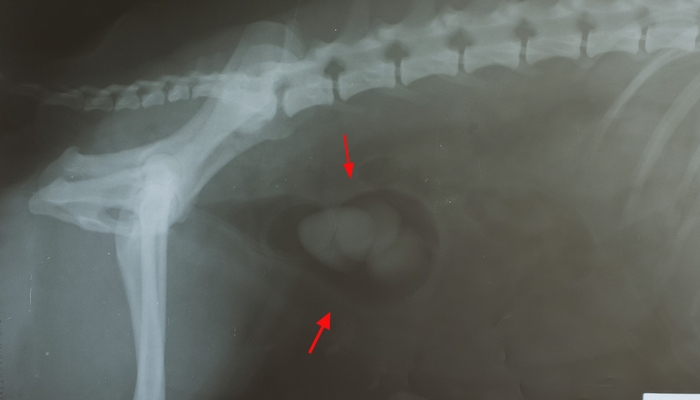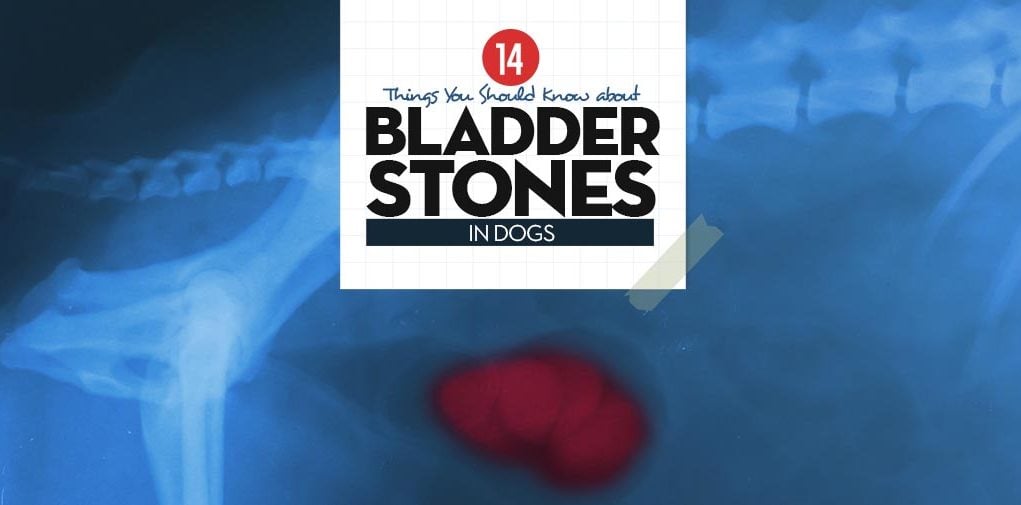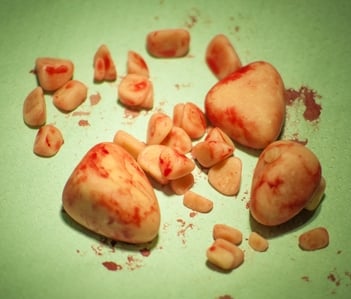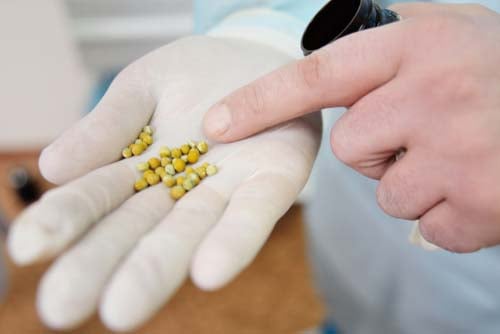Bladder stones (urolithiasis) are clumps of mineral crystals that form in the urine.
They can occur for several reasons, including genetics, diet, environment, and long-term medication (1).
Regardless of the exact cause, bladder stones in dogs will cause your pet serious discomfort.
The stones themselves vary widely in size (2).
Many dogs can develop and pass the stones without you even noticing.
Unfortunately, if the stones are large in size, your dog may not be able to pass them on its own.
In extreme cases, bladder stones can cause blockages and even be life-threatening (3).
Visit your veterinarian as soon as you suspect that your dog is at risk.
Once diagnosed, it's possible to treat a dog's bladder stones with home remedies. When stones are too large (or there are too many), surgical removal is required in more severe cases.
Table of Contents
 Bladder Stones in Dogs: Types of Stones
Bladder Stones in Dogs: Types of Stones
Bladder stones are clumps of minerals that resemble a stone.
Despite the name, they can appear not only in a dog's bladder but also in kidneys, urethra, or ureters.
There are several types of bladder stones due to the different mineral compounds that they are composed of.
In nearly 50% of bladder stone cases, dogs suffer from Struvite stones (4, 5). These are made up of magnesium ammonium phosphate hexahydrate crystals.
This compound would ordinarily be dissolved within the urine and be ready to safely depart the dog's body.
In bladder stones, these particles become solid again, and the reasons for this aren't well-known. They're more common in female dogs than male dogs.
Calcium oxalate stones are the second most common type, accounting for over 41% of cases of bladder stones (6).
These stones cannot be medically dissolved and need to be removed manually.
Senior dogs, male dogs, and neutered dogs are at greater risk of developing calcium oxalate stones (7). These stones are also the most reoccurring, where studies reported their recurrence in nearly half of the dogs in 3 years (8).
Only in about 5% of cases, the Urate stone will be the culprit. However, most dogs are protected from these stones.
Dalmatians are the only breed predisposed to urate stones due to a genetic mutation they suffer (9, 10).
This defect specifically relates to the metabolism of uric acid (11).
Cystine stones are rare, and in over 98% of cases, they are found in male dogs (12).
They're also more common in older male dogs than puppies, and apparently, geography matters too: European dogs are more predisposed to develop cystine stones when compared to American dogs (13).
Two other less common types of bladder stones in dogs are Silica stones and Calcium Phosphate stones.
The mineral composition of dog uroliths (14):
| Stone type | Percentage (%) |
|---|---|
| Struvite | 39.0 |
| Calcium oxalate | 41.3 |
| Urate | 5.0 |
| Cystine | 1.1 |
| Mixed | 2.8 |
| Compound | 9.1 |
Not always a cause for concern; many small stones pass through the dog's urinary tract without you or your pooch ever noticing.
However, for larger stones or groupings of smaller stones, this can cause an issue that requires medical intervention.
Symptoms of bladder stones in dogs include:
- bloated or sensitive tummy
- avoidance of exercise
- evading stroking or cuddling
- bloody urine
- discomfort or difficulty urinating
- cloudy or discolored urine
- change in thirst level
- irritability
- change in energy levels
- reluctance to move
- frequent attempts to urinate with little to no excretion
How Serious is This Condition?
A dog's immune system is effective at flushing out bladder stones most of the time.
However, in some cases, surgical removal is the only option. This usually happens when the bladder stone is too large, or there are too many for the dog to easily or safely pass through the urinary tract.
Just like in humans, bladder stone problems are a reasonably common condition in dogs.
Your veterinarian will likely have dealt with this issue many times before.
What Causes Bladder Stones in Dogs?
Some dog breeds are more prone to developing bladder stones (15, 16):
- Basset Hound
- Beagle
- Bulldog
- Cocker Spaniel
- Dachshund
- Dalmatian
- Miniature Schnauzer
- Pekingese
- Pug
- Welsh Corgi
There are many other reasons why a dog would develop bladder stones, too.
Some environmental and genetic factors have been shown to play the most significant role in their development and recurrence.
Below are the four most common causes.
1. Dog's Urine pH
The pH balance of your dog’s urine is a key factor in whether or not your pooch will develop this problem.
A pH level that is too low or too high can allow the crystals (that ultimately become bladder stones) to form in the first place.
A healthy dog's urine pH level should be between 5.5 and 7 (17).
A vet can test for this, but they will require a fresh urine sample because otherwise, results will be inconclusive.
It’s easy to adjust a dog’s urine pH levels through diet, with specific foods known to increase or decrease the pH level.
2. Diabetes
There is a correlation between dogs that suffer endocrine conditions such as diabetes and the formation of bladder stones.
Most diabetic dogs suffer from frequent urinary tract infections, a fundamental cause of bladder stones in dogs.
Around 40% of healthy dogs have struvite crystals in their urine, but the catalyst to turn crystals into stones in 98% of cases was a UTI.
If your dog suffers from an endocrine disorder, helping to defend against UTI is your first line of defense against bladder stones.
With the prevalence of antibiotic resistance, many veterinarians now recommend a natural remedy first.
3. Diet
Vitamins and minerals are crucial for a well-balanced canine diet.
For both prevention and treatment, you can make certain dietary changes through home food and commercial kibble.
Generally, a diet that's too high in minerals may cause or worsen bladder stone problems in a dog.
Certain breeds, such as the Dalmatian, have a greater risk.
If evidence suggests that your dog is predisposed to bladder stones, speak to a vet and develop a diet plan that won't aggravate your pet's sensitivity.
4. Medications
Some medications have the side effect of developing bladder stones in dogs because they alter the pH levels of a dog’s urine and cause an increase in calcium.
Short-term medications will have little to no effect. If a dog must remain on medication long-term, ensure that they drink enough water to help flush the system.
There are ways to encourage your dog to drink more, and adding a little salt to your pet's meals is one of them.
Check with a vet before attempting this.
You can also adjust a dog's diet to include more acidic or alkaline ingredients, which will even out the disruption caused by the medication.
How Can I Tell if My Dog Has Bladder Stones?
If your dog is exhibiting one or more bladder stone symptoms, go to a vet clinic. They will determine whether bladder stones are present by taking urine samples and performing x-rays.
In some cases where the condition has progressed, a vet may be able to feel a thickening of a dog's bladder wall or even the stones themselves.
If found, they will perform an ultrasound to determine the size and shape of bladder stones to confirm whether or not surgery is necessary.
7 Bladder Stones in Dog's Home Remedies
There are a few home treatments for bladder stones in dogs that are effective. As with any at-home treatments, discuss the method with your veterinarian beforehand.
1. Homemade Diet
Not all commercial foods can meet the needs of a dog with a specific health problem.
In some cases, a homemade dog food diet – when done properly – can be the best answer to fighting bladder stones in dogs.
As long as you discuss the recipes with a vet or canine nutritionist and find them well-balanced enough. This can become a life-saver.
2. Cranberry Extract
With UTI in dogs being the catalyst for most bladder stones, preventing and treating this condition should be your first line of defense.
A good quality cranberry extract or tablet can help even the most UTI-prone canines, but it does take a high-dose supplement.
Cranberry juice, dried cranberries, or fresh cranberries are not potent enough to provide any benefit. They’re also not the most palatable food for a dog.
The three best cranberry supplements for dogs with UTI or bladder stones are:
| Preview | Product | Rating | |
|---|---|---|---|

|
Zesty Paws Cranberry Bladder Bites for Dogs -... | 12,322 Reviews | Check Price |

|
NaturVet – Cranberry Relief Plus Echinacea –... | 8,376 Reviews | Check Price |

|
Amazing Cranberry for Dogs Pet Antioxidant,... | 4,362 Reviews | Check Price |
3. Apple Cider Vinegar
The most popular remedy for treating bladder stones in a dog at home is apple cider vinegar. This solution was shown to be good at healing and preventing a multitude of other conditions, too. A potent detoxifying agent, just a few drops of apple cider vinegar can help normalize your pup's pH levels.
Most apple cider vinegar brands are the same in their ingredients, but you can choose a raw, unfiltered, and organic brand like Bragg for best results. Bragg's apple cider vinegar (or any other similar ones) is unheated and unpasteurized, with a 5% acidity level. This is what you need for a dog with bladder stones.
4. Rhubarb Root
A lesser-known home remedy for bladder stones in dogs is the rhubarb root. You can purchase these from your local Chinese (or other Asian) medicinal stores or a holistic veterinarian. Rhubarb is especially powerful at helping the body rid itself of unwanted waste and boosting bladder health.
5. Parsley
A natural diuretic, parsley, can be added to your dog's homemade diet or fed directly to the dog as a supplement. Parsley helps a dog to flush their system as often as possible. However, don’t forget that you’ll have to let your pet out more often when feeding this or any other diuretic home remedy or supplement.
6. Probiotics
One reason that a dog can develop bladder stones is a digestive system that isn’t working correctly. Adding a dog probiotic into your dog's homemade meal, commercial food, or just water can help prevent or fix the problem.
Probiotics that spread good bacteria in a dog's gut also benefit from improving the overall digestive system, gut health, and immune system.
7. Increase Water Consumption
Some dogs do not drink as much water as their body needs. If that's your pet, think of creative ways to encourage your dog's increase in fluid intake. A good starting point is switching to wet dog food which contains a little more sodium. You can also make frozen homemade dog treats with plenty of ice, hiding treats in ice cubes, or adding chicken or bone broth to dry food.
3 Vet Treatments for Bladder Stones in Dogs
1. Surgical Removal
When symptoms are at their most intense, this is often a sign of a larger stone which may require surgical removal. The vet will put your dog under general anesthetic, and a cystotomy will be performed.
This is when the veterinarian will make an incision to expose the bladder and then open it to remove each stone manually. This type of surgery is pretty routine, and while all surgery carries its risks, the success rate of this surgery is very high.
In over 97% of cases, the surgeon will surgically remove bladder stones in dogs from the lower urinary tract (18). Non-invasive methods are, in fact, available (e.g., laser lithotripsy, ESWL, or ureteric stenting), but most vet clinics will not have them simply because vets are comfortable performing the surgery (19, 20). Non-invasive ways are more expensive.
In some cases, where a stone is causing a blockage, emergency surgery will need to be performed immediately. Make yourself aware of the symptoms so that you can take your dog to receive treatment without delay.
2. Medication
There are medications available that will be able to shrink or dissolve bladder stone in a dog. Discuss with your veterinarian whether this is an option. If your pooch is already on other medications, this might not be possible.
3. Prescription Diet
Often used short-term, a prescribed commercial dog food brand will be recommended by a veterinarian to rid a dog of this condition. Upon successfully dissolving bladder stones, you can then place your pet on a different diet (likely not the same one that the dog was on before developing stones).
The best dog food for bladder stones and urinary health you can find right now:
| Preview | Product | Rating | |
|---|---|---|---|

|
Blue Buffalo Natural Veterinary Diet W+U Weight... | 149 Reviews | Check Price |

|
Purina Canine UR Urinary Ox/St Dog Food (Dry) 6 LB | 233 Reviews | Check Price |

|
Hill's Prescription Diet c/d Multicare Urinary... | 437 Reviews | Check Price |
Final Thoughts
The size of bladder stones in dogs can be anywhere from the size of a grain of sand and all the way up. As luck would have it, the best ways to prevent these masses from forming are also the ways to improve your canine’s overall health.
The prognosis for dogs who develop bladder stones is generally good, especially for those that didn’t suffer from a blockage. If your pet has suffered from this affliction, it’s important to do your research into the lifelong holistic and medical management required to ensure that the stones do not return.
READ NEXT: 5 Bladder Problems in Dogs
Disclosure: We may earn affiliate commissions at no cost to you from the links on this page. This did not affect our assessment of products. Read more here and find full disclosure here.


















